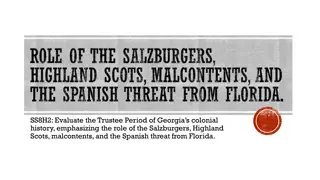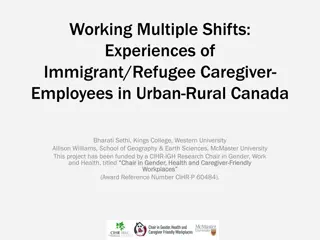Exploring Colonial Georgia: The Trustee Period and Immigrant Communities
Colonial Georgia was governed by trustees from 1732 until 1753, with strict rules imposed on colonists. Despite this, diverse groups such as Highland Scots, Salzburgers, and Jews immigrated to Georgia, making significant contributions. The Salzburgers, German Protestants seeking religious freedom, settled in Ebenezer and worked on silk cultivation and agriculture. Their industrious efforts led to success in various ventures, showcasing resilience and adaptation in a challenging environment.
Download Presentation

Please find below an Image/Link to download the presentation.
The content on the website is provided AS IS for your information and personal use only. It may not be sold, licensed, or shared on other websites without obtaining consent from the author. Download presentation by click this link. If you encounter any issues during the download, it is possible that the publisher has removed the file from their server.
E N D
Presentation Transcript
Trustee Period
Trustees The Charter of 1732 gave 21 trustees the right to govern Georgia until 1753. They could govern the colony for 21 years, after that, the colony s government was to pass to the ruler of England. To assure that they would not act out of self-interest, Georgia s charter prohibited several activities.
Trustees They could not receive a salary, own land in the colony, or hold public office. During the Trustee Period, Oglethorpe was the unofficial leader of Georgia. The trustees were not allowed to benefit personally from decisions they made.
Rules The Trustees had a plan for Georgia that included several strict rules for the colonists. Some rules include limits on land ownership, no hard liquor, no slavery, no Catholics or Jews, and inheritance laws that passed down family land to sons only. Many of these rules angered Georgia s colonists.
Immigrants Despite the strict rules, people from all over Europe heard about the new colony and began to immigrate there. Many diverse groups, including the Highland Scots, the Salzburgers, and the Jews, joined the settlement in Savannah and made a significant impact on the Georgia colony.
Salzburgers The largest ethnic group during the Trustee Period were German Protestants from Salzburg (in present-day Austria). The Salzburgers came to Georgia in 1734 seeking religious freedom and hoping to establish a silk industry in the colony.
Salzburgers The Salzburgers were given land 25 miles north of Savannah that they named Ebenezer ( the Rock of Help ). In Ebenezer, they worked hard, but the land was marshy with poor soil for crops. They eventually asked Oglethorpe for a better site and moved to a new location on the Savannah River.
Salzburgers In New Ebenezer, they planted mulberry trees and cultivated silk from silkworms that fed on the leaves. They were also successful in lumber production, cattle raising, and agriculture.
Highland Scots Oglethorpe was concerned with the military threat posed by the Spanish in Florida so he recruited another group of immigrants to help defend the colony. In January 1736, 177 Scottish soldiers known as the Highland Scots established the town of Darien. The Highland Scots were fierce fighters well-known for bravery in battle.
Highland Scots When the Highland Scots realized the soil was not good for crops, they established successful timber and cattle industries. The Highland Scots created the first Presbyterian Church in Georgia. In 1739, they signed the first anti-slavery petition in the South. The Highland Scots were crucial in defending the colony against Spanish invasions.
JEWS In 1733, a group of 42 Portuguese Jews arrived in Savannah s harbor and asked permission to join the settlement. The Charter of 1732 forbade Jews from settling in Georgia, and Oglethorpe was unsure of what to do.
JEWS At the time, the colonists faced many illnesses like scurvy, dysentery, and fever. Nearly one-fourth of the colonists had died from illness, including the colony s only doctor. When it was discovered that there was a doctor among the Jewish immigrants, Oglethorpe agreed to let them join the settlement.
JEWS Doctor Samuel Nunes helped cure many of the colonists illnesses. With his help, the medical crisis in the new colony passed. Dr. Nunes became Georgia s official doctor and was credited with helping save the colony.
Malcontents Many colonists became angry as economic hardship met the colony. They saw that the colony of South Carolina, which allowed selling land, alcohol, and slaves, was very successful. These malcontents were not happy and demanded the Trustees make some changes.
Malcontents Many of the malcontents had paid their own way to come to Georgia and were hoping to get rich off the land using slave labor. They believed that the Trustees policies kept the colony from prospering. The malcontents said that Georgia would never grow unless people were allowed to buy and sell land and use slaves in their fields. Oglethorpe had little time to resolve the problems because a Spanish invasion was imminent.
Spanish Threat The Charter of 1732 required Georgia to protect South Carolina from the Spanish in Florida. Oglethorpe began building forts along Georgia s barrier islands with the intention of preventing Spanish attacks from reaching Savannah. When the Spanish began an invasion on the Georgia colony, Oglethorpe, along with the Highland Scots and other colonists, was prepared.
Spanish Threat In 1742, a Spanish forced landed on St Simons Island. Oglethorpe s much smaller force defended Fort Frederica and defeated the Spanish in the Battle of Bloody Marsh. After this battle, the Spanish gave up all claims to Georgia. The Spanish loss marked the beginning of a safe southern border.
Trustee Period Ends In the end, the Trustees economic and social plans for Georgia proved unsuccessful. Georgia did achieve its goal of defending South Carolina from the Spanish; however, it failed with the other aspects of the Trustees plan for a model society. By 1750, land could be bought and sold, slavery was legal, and liquor was allowed in the colony.
Royal Colony In 1752, the Charter of 1732 expired and the Trustees surrendered control of the colony to the King. Many rules and regulations changed once Georgia became a royal colony. Restrictions on land ownership and slavery were removed and Georgia began to prosper economically.
Cash Crops With land restrictions lifted, colonists were able to build huge plantations along the river deltas where they used slaves to cultivate rice in the fertile marshlands. The tobacco industry boomed and it became one of Georgia s most valuable cash crops on the world market. Other successful cash crops included rye, wheat, peas, corn, and indigo (blue dye was popular in England).
Cash Crops The colonists began raising cows, horses, mules, and pigs. They started cutting down the region s forests for lumber. They also traded with the American Indians for animal hides. Soon, Georgia began exporting these products to Europe and the West Indies.
Slavery Georgia s economy now relied heavily on slave labor. Georgia s enslaved African population grew drastically from less than 500 in 1750 to 18,000 in 1775.
Government The new royal government needed new government officials, including an attorney general, head of military, and a royal governor. There was also a legislature that was made up of a council, court of appeals, and two representatives from each county in the colony.
King George II appointed a royal governor to oversee Georgia s development. The royal governor acted as the king s voice in the colony and performed administrative duties. The royal governor wielded great power, but also worked closely with the legislature.
John Reynolds Georgia s first governor was John Reynolds, who served from 1754 to 1756. He was a former naval officer. Reynolds had many conflicts with the colonial legislature, so the king revoked his position.
Henry Ellis Explorer Henry Ellis served as the next governor from 1757 to 1760. He worked well with the legislature and the American Indians. Ellis showed the colonists how to govern themselves, explaining the need for a budget, taxes, and military defense. He left office in 1760 due to poor health.
James Wright Georgia s final royal governor, James Wright, served from 1760 to 1776. He was a popular governor who negotiated important treaties with the Creek Indians that opened up millions of acres for settlement. Georgia prospered and grew faster than any other English colony under Wright s leadership. Wright stayed loyal to England when the Revolutionary War began and was eventually arrested.
Legislature In addition to a governor, the new royal government also included a legislature. The upper house of the bicameral legislature included officials appointed by the king. Georgians were allowed to elect members to the lower house, which was Georgia s first opportunity at self-government.
Restrictions Even though colonists now had a voice in the government, their say was still limited. Only white male citizens who owned at least 50 acres of land were allowed to vote. A colonist could only be elected to the legislature if he owned more than 500 acres of land. The king (or governor) could veto any law passed by the legislature.























